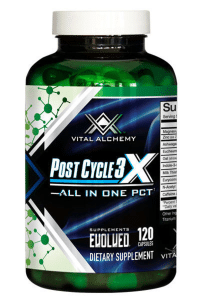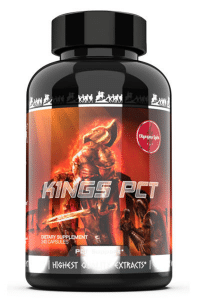Post-Cycle Therapy (PCT) stands as a pivotal phase in the realm of performance enhancement, representing a critical juncture for individuals who have undergone anabolic or performance-enhancing cycles. As enthusiasts and athletes pursue the benefits of increased muscle mass and enhanced physical performance during these cycles, the subsequent challenge lies in maintaining those hard-earned gains once the cycle concludes.
The journey through anabolic use is a double-edged sword, as while it brings about notable advancements in muscle growth and strength, it also initiates a cascade of hormonal changes within the body. The suppression of endogenous testosterone production becomes a looming threat, posing a risk to the preservation of muscle mass and overall well-being. This is where Post-Cycle Therapy steps into the spotlight, offering a strategic and scientifically guided approach to navigating the delicate hormonal landscape post-cycle.
Understanding On-Cycle Muscle Gains
Anabolic and performance-enhancing drugs (PEDs) have become synonymous with the pursuit of muscle gains among athletes and bodybuilders. Understanding how these substances contribute to muscle growth is crucial for those looking to optimize their on-cycle experience.
Anabolics and Muscle Growth
The pursuit of muscle gains often leads individuals to explore the world of anabolics and performance-enhancing drugs (PEDs). These substances work by enhancing the body’s ability to build muscle through several mechanisms:
Increased Protein Synthesis:
- Anabolic products stimulate protein synthesis, the process by which the body builds new proteins, including muscle tissue.
- This acceleration of protein synthesis leads to a positive nitrogen balance, promoting muscle growth.
Elevated Red Blood Cell Production:
- Some PEDs, like erythropoietin, boost red blood cell production, improving oxygen delivery to muscles during exercise.
- Enhanced oxygenation supports greater endurance and muscle performance.
Androgen Receptor Activation:
- Anabolics bind to androgen receptors in muscle cells, triggering gene expression for muscle development.
- This androgenic effect contributes to increased muscle size and strength.
Water Retention and Glycogen Storage
Water Retention:
- Some supplements may cause water retention, leading to a temporary increase in muscle size.
- This is often a cosmetic effect, and the retained water is lost post-cycle.
Glycogen Storage:
- They can promote increased glycogen storage in muscles, providing a readily available energy source.
- Enhanced glycogen levels contribute to sustained energy during workouts, supporting prolonged and intense training sessions.
Role of Nutrition and Training
Proper Nutrition:
- Adequate protein intake is paramount for muscle growth during the on-cycle phase.
- Ensure a balanced diet rich in essential nutrients to support overall health and optimize performance.
Strategic Training:
- Focus on compound exercises that target multiple muscle groups.
- Incorporate progressive overload to continually challenge muscles and stimulate growth.
Individualized Approach:
- Tailor nutrition and training to individual needs and response to the cycle.
- Regularly assess and adjust the plan based on progress and feedback from the body.
In the pursuit of on-cycle muscle gains, it’s essential to strike a balance between pharmacological support, proper nutrition, and effective training strategies. This holistic approach sets the foundation for sustained progress and primes the body for a successful post-cycle transition.

It should be noted that the importance of a well-structured post-cycle therapy plan cannot be overstated, especially when considering long-term health and hormonal balance. For guidance on the top 5 pct strategies, for better understanding.
The Need for Post-Cycle Therapy
After completing a cycle of anabolic or performance-enhancing drugs, the body undergoes significant hormonal shifts, creating an environment that necessitates careful intervention through Post-Cycle Therapy (PCT).
Hormonal Imbalances:
Hormonal imbalances are a hallmark of the post-cycle period. The body, accustomed to external hormonal support during the cycle, experiences a sudden drop in synthetic hormones. This triggers a cascade of reactions, leading to imbalances in estrogen, testosterone, and other crucial hormones.
- Estrogen Fluctuations: The abrupt discontinuation of exogenous hormones can result in elevated estrogen levels, contributing to water retention and potential mood swings.
- Testosterone Deficiency: Natural testosterone production is suppressed during a cycle, and the body needs time to kickstart its endogenous production post-cycle.
Suppression of Natural Testosterone Production:
The suppression of natural testosterone production is a primary concern post-cycle. Anabolics signal the body to cease its own testosterone synthesis, and when external sources are removed, the body may struggle to resume its normal production.
- Hypogonadism Risk: Prolonged suppression can lead to a condition known as hypogonadism, where the testes fail to produce adequate testosterone naturally.
- Impact on Libido and Energy: Reduced testosterone levels post-cycle can result in decreased libido, fatigue, and a general sense of low energy.
Risks of Neglecting PCT:
Neglecting Post-Cycle Therapy poses serious risks that extend beyond hormonal imbalances, with potential consequences for muscle mass and overall health.
- Muscle Loss: Without proper intervention, the body may enter a catabolic state, breaking down hard-earned muscle tissue. This can reverse the gains achieved during the cycle.
- Gynecomastia and Water Retention: Unchecked estrogen levels post-cycle may lead to gynecomastia (enlargement of male breast tissue) and water retention, undermining the desired lean physique.
- Mood Swings and Emotional Well-being: Hormonal fluctuations can influence mood, potentially leading to irritability, anxiety, or even depression if not addressed.
It’s crucial to emphasize that neglecting Post-Cycle Therapy is akin to abandoning the ship after a long voyage; it leaves the body vulnerable to the turbulent seas of hormonal imbalance.
To address these challenges effectively, incorporating top recommended PCT supplements can play a pivotal role. These supplements are designed to support hormone balance, mitigate side effects, and aid in a smoother transition back to the body’s natural hormonal rhythm. Always consult with healthcare professionals to tailor a PCT plan that suits individual needs, mitigates risks, and ensures a successful recovery.
Components of an Effective Post-Cycle Therapy
Post-cycle therapy (PCT) is a critical phase for individuals who have undergone anabolic cycles to ensure a smooth transition back to natural hormonal balance. This phase involves several key components, each playing a crucial role in preserving hard-earned muscle gains. Here, we delve into the essential elements of an effective post-cycle therapy.
Introduction to SERMs and their role in PCT
- Understanding SERMs: Selective Estrogen Receptor Modulators, commonly known as SERMs, are pivotal in mitigating the effects of estrogen rebound post-cycle.
- Role in Hormonal Balance: SERMs work by binding to estrogen receptors, preventing excessive estrogen activity and assisting in restoring the delicate balance between estrogen and testosterone.
- Common SERMs Used in PCT: Notable SERMs include Tamoxifen and Clomiphene, both widely employed in post-cycle therapy protocols.
- Usage Guidelines: SERMs are typically introduced after the anabolic cycle to curb estrogenic side effects and kickstart the body’s natural testosterone production.
Explanation of HCG and its use in kickstarting testosterone production
- Understanding HCG: Human Chorionic Gonadotropin, or HCG, is a hormone that mimics luteinizing hormone (LH), crucial for stimulating testosterone production.
- Kickstarting Natural Testosterone: HCG is introduced early in PCT to mimic LH and prevent testicular atrophy, jumpstarting the testes to produce testosterone.
- Combination with SERMs: Often used in conjunction with SERMs, HCG addresses different aspects of hormonal recovery, providing a comprehensive approach to post-cycle therapy.

- Dosage Considerations: Proper dosage is crucial to avoid desensitizing the testes to the effects of HCG, striking a balance between stimulating testosterone production and preventing potential side effects.
Importance of proper timing and dosage in PCT protocols
- Timing Significance: Initiating PCT at the right time post-cycle is vital. Starting too early may hinder recovery, while delaying PCT can lead to muscle loss and other complications.
- Understanding Half-Lives: Consideration of the half-lives of anabolics used in the cycle is paramount for determining when to begin post-cycle therapy.
- Gradual Tapering: Dosage adjustments should follow a gradual tapering approach, allowing the body to adjust slowly and minimizing the risk of rebound effects.
- Individual Variability: Recognizing that each individual may respond differently to PCT is crucial. Regular monitoring and adjustments based on individual reactions enhance the effectiveness of the post-cycle therapy plan.
Nutritional Strategies for Post-Cycle Maintenance
After completing a cycle, the significance of nutritional strategies cannot be overstated. Proper nutrition plays a pivotal role in restoring hormonal balance, preserving muscle mass, and supporting overall recovery. Here’s a breakdown of essential nutritional considerations for effective post-cycle maintenance.
Overview of the impact of nutrition on hormonal balance
- Nutrition’s Influence on Hormones: Hormones, including testosterone and cortisol, are intricately linked to nutrition. Balanced and proper nutrition can aid in restoring hormonal equilibrium after the stress induced by anabolic use.
- Role of Macronutrients: Protein, carbohydrates, and fats each play a unique role in hormonal regulation. Achieving a balanced macronutrient intake is crucial for overall health and hormonal recovery.
- Avoiding Nutrient Deficiencies: Deficiencies in key nutrients can disrupt hormonal production. Ensuring a varied and nutrient-rich diet helps prevent imbalances that may hinder post-cycle recovery.
Importance of adequate protein intake for muscle preservation
- Protein and Muscle Preservation: Adequate protein intake is paramount for preserving muscle mass during the post-cycle phase. Protein provides the essential amino acids needed for repair and recovery.
- Protein Sources: Lean meats, fish, dairy products, and plant-based protein sources should be incorporated to meet protein requirements. Protein shakes can also be beneficial to supplement daily intake.
- Timing and Distribution: Spreading protein intake evenly throughout the day and consuming protein-rich meals post-workout can optimize muscle protein synthesis and aid in the recovery process.
Role of micronutrients and supplements in supporting recovery
- Micronutrients and Hormonal Regulation: Micronutrients such as vitamins and minerals play a crucial role in hormonal balance. For example, zinc and magnesium are essential for testosterone production.
- Supplements for Recovery: Omega-3 fatty acids, antioxidants, and adaptogenic herbs can be valuable supplements. They help reduce inflammation, combat oxidative stress, and support the body’s overall recovery.
- Vitamin D and Calcium: Ensuring adequate levels of vitamin D and calcium is vital for bone health, especially considering potential bone density concerns associated with some anabolics.
- Consultation with a Nutritionist: Tailoring micronutrient intake to individual needs is recommended. Consulting with a nutritionist can help develop a personalized plan based on specific requirements and potential deficiencies.
Conclusion
In conclusion, post-cycle therapy encapsulates more than a recovery phase; it symbolizes a commitment to responsible and informed use of anabolic substances. By navigating this journey with diligence, individuals can not only retain hard-earned muscle gains but also foster a foundation for long-term health, resilience, and an enduring passion for fitness and well-being.

